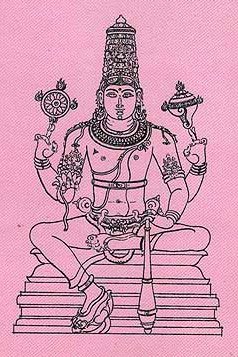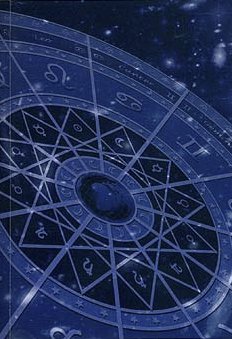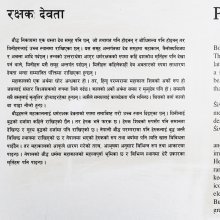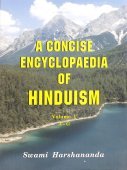Ghora, Ghorā, Ghoradarshana: 34 definitions
Introduction:
Ghora means something in Buddhism, Pali, Hinduism, Sanskrit, Jainism, Prakrit, Marathi, Hindi. If you want to know the exact meaning, history, etymology or English translation of this term then check out the descriptions on this page. Add your comment or reference to a book if you want to contribute to this summary article.
Images (photo gallery)
In Hinduism
Shaivism (Shaiva philosophy)
Source: Wisdom Library: Kubjikāmata-tantra1) Ghorā (घोरा):—One of the twelve guṇas associated with Dhvaja, the fourth seat of the Svādhiṣṭhāna-chakra. According to tantric sources such as the Śrīmatottara-tantra and the Gorakṣasaṃhitā (Kādiprakaraṇa), these twelve guṇas are represented as female deities. According to the Ṣaṭsāhasrasaṃhitā however, they are explained as particular syllables. They (e.g. Ghorā) only seem to play an minor role with regard to the interpretation of the Devīcakra (first of five chakras, as taught in the Kubjikāmata-tantra).
2) Ghorā (घोरा):—Sanskrit name of one of the thirty-two female deities of the Somamaṇḍala (second maṇḍala of the Khecarīcakra) according to the kubjikāmata-tantra. These goddesses are situated on a ring of sixteen petals and represent the thirty-two syllables of the Aghoramantra. Each deity (including Ghorā) is small, plump and large-bellied. They can assume any form at will, have sixteen arms each, and are all mounted on a different animal.
Source: Shodhganga: Iconographical representations of ŚivaGhora (घोर) or Ghorāgama refers to one of upāgamas (supplementary scriptures) of the Niśvāsāgama which is one of the twenty-eight Siddhāntāgama: a classification of the Śaiva division of Śaivāgamas. The Śaivāgamas represent the wisdom that has come down from lord Śiva, received by Pārvatī and accepted by Viṣṇu. The purpose of revealing upāgamas (e.g., Ghora Āgama) is to explain more elaborately than that of mūlāgamas (e.g., Niśvāsa-āgama) and to include any new idea if not dealt in mūlāgamas.

Shaiva (शैव, śaiva) or Shaivism (śaivism) represents a tradition of Hinduism worshiping Shiva as the supreme being. Closely related to Shaktism, Shaiva literature includes a range of scriptures, including Tantras, while the root of this tradition may be traced back to the ancient Vedas.
Purana and Itihasa (epic history)
Source: archive.org: Puranic EncyclopediaGhora (घोर).—A son of sage Aṅgiras. (Anuśāsana Parva, Chapter 85, Verse 131).
Source: Cologne Digital Sanskrit Dictionaries: The Purana IndexGhora (घोर).—The 25th kalpa.*
- * Matsya-purāṇa 290. 9.
Ghora (घोर) is a name mentioned in the Mahābhārata (cf. XIV.8.28, XIV.8) and represents one of the many proper names used for people and places. Note: The Mahābhārata (mentioning Ghora) is a Sanskrit epic poem consisting of 100,000 ślokas (metrical verses) and is over 2000 years old.

The Purana (पुराण, purāṇas) refers to Sanskrit literature preserving ancient India’s vast cultural history, including historical legends, religious ceremonies, various arts and sciences. The eighteen mahapuranas total over 400,000 shlokas (metrical couplets) and date to at least several centuries BCE.
Pancaratra (worship of Nārāyaṇa)
Source: Wisdom Library: PāñcarātraGhora (घोर) refers to an aspect of nṛsiṃha (‘man-lion’), according to the Vihagendra-saṃhitā 4.17, which mentions seventy-four forms (inlcuding twenty forms of vyūha). He is also known as Ghoranṛsiṃha or Ghoranarasiṃha. Nṛsiṃha is a Tantric deity and refers to the furious (ugra) incarnation of Viṣṇu.
The 15th-century Vihagendra-saṃhīta is a canonical text of the Pāñcarātra corpus and, in twenty-four chapters, deals primarely with meditation on mantras and sacrificial oblations.
Source: University of Vienna: Sudarśana's Worship at the Royal Court According to the AhirbudhnyasaṃhitāGhora (घोर) refers to a “terrifying (sight)”, according to the Ahirbudhnyasaṃhitā, belonging to the Pāñcarātra tradition which deals with theology, rituals, iconography, narrative mythology and others.—Accordingly, “An abnormal modification caused by a aggressive ritual against Kings, occurring at the improper time, dreadful and all-reaching, is characterized by the these signs: Suddenly horses, elephants and ministers perish, the king himself suffers from a serious illness which has seized [his] body; terrifying (ghora-darśana) thunderbolts strike his dominion; [...] from such and other signs he should understand that the enemy is performing a aggressive ritual”.

Pancaratra (पाञ्चरात्र, pāñcarātra) represents a tradition of Hinduism where Narayana is revered and worshipped. Closeley related to Vaishnavism, the Pancaratra literature includes various Agamas and tantras incorporating many Vaishnava philosophies.
Shaktism (Shakta philosophy)
Source: Google Books: Manthanabhairavatantram1) Ghorā (घोरा) refers to “fierce”, according to the Manthānabhairavatantra, a vast sprawling work that belongs to a corpus of Tantric texts concerned with the worship of the goddess Kubjikā.—[...] In the course of the initiation that renders him fit to worship the deity, the adept is purified of his sins and spiritual impurities by this penetration. It is brought about by the goddess herself who is the Transmental (unmanā), that is, by her Command of which it is a sign. And so although the goddess is benign (aghorā), she appears to be fierce (ghorā), because of the awesome power of the infusion of energy that her devotee experiences in this way.
2) Ghora (घोर) refers to one of the eight Guardians (kṣetrapāla-aṣṭaka) associated with Jālandhara (which is in the southern quarter), according to the Manthānabhairavatantra.—[...] The eight guardians: Agnivetāla, Jayanta, Jvālāmukha, Bhīmanāda, Ghora, Meghanāda, Mahākāla, Khaga.
3) Ghorā (घोरा) refers to one of the six Goddesses (parā-ṣaṭka) associated with Tisrapīṭha (located in the ‘end of sound’—nādānta), according to the Manthānabhairavatantra.—[...] The six Goddesses (parāṣaṭka): Tisrāvvā, Aghoranāyikā, Ghorā, Ghoratarāvvā, Yakṣiṇī, Khañjinī.
4) Ghora (घोर) refers to one of the eight Guardians (kṣetrapāla-aṣṭaka) associated with Nādapīṭha (identified with Kulūta), according to the Manthānabhairavatantra.—[...] The eight Guardians (kṣetrapālāṣṭaka): Ekapāda, Budbuda, Ghaṇṭāvādanaka, Ghora, Gharghara, Valkala, Līla, Laṅkeśvara.
Source: Shodhganga: Iconographical representations of Śiva (shaktism)Ghora (घोर) or Ghoratantra refers to one of the thirty-three Dakṣiṇatantras, belonging to the Śāktāgama (or Śāktatantra) division of the Āgama tradition. The Śāktāgamas represent the wisdom imparted by Devī to Īśvara and convey the idea that the worship of Śakti is the means to attain liberation. According to the Pratiṣṭhālakṣaṇasamuccaya of Vairocana, the Śāktatantras are divided into to four parts, the Ghora-tantra belonging to the Dakṣiṇa class.

Shakta (शाक्त, śākta) or Shaktism (śāktism) represents a tradition of Hinduism where the Goddess (Devi) is revered and worshipped. Shakta literature includes a range of scriptures, including various Agamas and Tantras, although its roots may be traced back to the Vedas.
Ayurveda (science of life)
Nighantu (Synonyms and Characteristics of Drugs and technical terms)
Source: WorldCat: Rāj nighaṇṭuGhorā (घोरा) is another name for Jīmūtaka, a medicinal plant identified with Luffa echinata (bitter sponge gourd or bitter luffa) from the Cucurbitaceae or “gourd family” of flowering plants, according to verse 3.58-60 of the 13th-century Raj Nighantu or Rājanighaṇṭu. The third chapter (guḍūcyādi-varga) of this book contains climbers and creepers (vīrudh). Together with the names Ghorā and Jīmūtaka, there are a total of nineteen Sanskrit synonyms identified for this plant.

Āyurveda (आयुर्वेद, ayurveda) is a branch of Indian science dealing with medicine, herbalism, taxology, anatomy, surgery, alchemy and related topics. Traditional practice of Āyurveda in ancient India dates back to at least the first millenium BC. Literature is commonly written in Sanskrit using various poetic metres.
Jyotisha (astronomy and astrology)
Source: Wisdom Library: Brihat Samhita by Varahamihira1) Ghora (घोर) refers to “fearful (deaths)”, according to the Bṛhatsaṃhitā (chapter 6), an encyclopedic Sanskrit work written by Varāhamihira mainly focusing on the science of ancient Indian astronomy astronomy (Jyotiṣa).—Accordingly, “If Mars should, after cutting through the constellation of Maghā, approach the middle of Viśākhā, there will be famine in the land; if he should cut through the constellation of Rohiṇī, there will be fearful deaths [i.e., ghora—marakaṃ karoti ghoraṃ yadi] in the land. If Mars should pass to the south of the constellation of Rohiṇī, rulers will suffer, prices will rise and there will be little rain; if Mars should appear enveloped in smoke or with a pointed flame, the people of Pāriyātra will perish”.
2) Ghora (घोर) refers to one of the seven “courses of Mercury” (Budhacāra), according to the Bṛhatsaṃhitā (chapter 7).—Accordingly, “If Mercury should pass through the constellations of Mūla and the two Āṣāḍhas, his course is known as Yogāntika. If such course should lie through the constellations of Śravaṇa, Citrā, Dhaniṣṭhā and Stvāṣṭra, it is known as Ghora. [...] When Mercury is in his Prākṛta course, there will be increase of health, of rain, of crops and there will be prosperity in the land. If he should be either in his Saṃkṣipta or Miśra course, mankind will be partly happy and partly miserable. When in his remaining four courses, Mercury brings on adversity”.

Jyotisha (ज्योतिष, jyotiṣa or jyotish) refers to ‘astronomy’ or “Vedic astrology” and represents the fifth of the six Vedangas (additional sciences to be studied along with the Vedas). Jyotisha concerns itself with the study and prediction of the movements of celestial bodies, in order to calculate the auspicious time for rituals and ceremonies.
In Buddhism
Tibetan Buddhism (Vajrayana or tantric Buddhism)
Source: Wisdom Library: Tibetan Buddhism1) Ghora (घोर) refers to one of the male Vidyā-beings mentioned [twice] as attending the teachings in the 6th century Mañjuśrīmūlakalpa: one of the largest Kriyā Tantras devoted to Mañjuśrī (the Bodhisattva of wisdom) representing an encyclopedia of knowledge primarily concerned with ritualistic elements in Buddhism. The teachings in this text originate from Mañjuśrī and were taught to and by Buddha Śākyamuni in the presence of a large audience (including Ghora).
2) Ghora (घोर) is also the name of a Rākṣasa mentioned as attending the teachings in the 6th century Mañjuśrīmūlakalpa.
3) Ghora (घोर) is also the name of a Piśāca mentioned as attending the teachings in the 6th century Mañjuśrīmūlakalpa.
4) Ghora (घोर) also refers to one of the various Grahas and Mahāgrahas mentioned as attending the teachings in the 6th century Mañjuśrīmūlakalpa.
Source: Wisdomlib Libary: VajrayoginiGhora (घोर) is the name of a cloud (megha) associated with Karaṅkaka: the western cremation ground (śmaśāna) according to the Vajravārāhī-sādhana by Umāpatideva as found in te 12th century Guhyasamayasādhanamālā. As a part of this sādhana, the practicioner is to visualize a suitable dwelling place for the goddess inside the circle of protection which takes the form of eight cremation grounds.
These clouds (e.g., Ghora) are known as cloud-kings (megharāja) and have names that are associated with the loud noises of thunderclouds and the noise of rain, according to the Guhyasamayasādhanamālā 11.77. Their presence in the cremation grounds may be connected with the nāgas, for they are known to be responsible for the rain.
Source: academia.edu: The Structure and Meanings of the Heruka MaṇḍalaGhora (घोर) refers to one of the eight cloud king (meghendra) of the Guṇacakra, according to the 10th century Ḍākārṇava chapter 15. Accordingly, the guṇacakra refers to one of the four divisions of the sahaja-puṭa (‘innate layer’), situated within the padma (lotus) in the middle of the Herukamaṇḍala. Ghora is associated with the charnel grounds (śmaśāna) named Jvālākulakaraṅka; with the tree (vṛkṣa) named Kaṅkelli; with the direction-guardians (dikpāla) named Varuṇa and with the serpent king (nāgendra) named Karkoṭa.

Tibetan Buddhism includes schools such as Nyingma, Kadampa, Kagyu and Gelug. Their primary canon of literature is divided in two broad categories: The Kangyur, which consists of Buddha’s words, and the Tengyur, which includes commentaries from various sources. Esotericism and tantra techniques (vajrayāna) are collected indepently.
Mahayana (major branch of Buddhism)
Source: academia.edu: A Study and Translation of the GaganagañjaparipṛcchāGhora (घोर) refers to “terror”, according to the Gaganagañjaparipṛcchā: the eighth chapter of the Mahāsaṃnipāta (a collection of Mahāyāna Buddhist Sūtras).—Accordingly, “[...] At that time, sixty koṭis of Bodhisattvas, having stood up from the congregation, joined their palms, paid homage to the Lord, and then uttered these verses in one voice: ‘[...] (207) In such a time of great terror (mahā-ghora) and disruption for living beings, agitating ascetics and kings alike, we will uphold the true dharma. (208) Any of the Sūtras will not be collected nor practiced; they will always believe what they say. [...]’”.

Mahayana (महायान, mahāyāna) is a major branch of Buddhism focusing on the path of a Bodhisattva (spiritual aspirants/ enlightened beings). Extant literature is vast and primarely composed in the Sanskrit language. There are many sūtras of which some of the earliest are the various Prajñāpāramitā sūtras.
In Jainism
General definition (in Jainism)
Source: archive.org: TrisastisalakapurusacaritraGhorā (घोरा) is the name of a vidyā subdued by Rāvaṇa, according to the Jain Ramayana and chapter 7.1 [origin of the rākṣasavaṃśa and vānaravaṃśa] of Hemacandra’s 11th century Triṣaṣṭiśalākāpuruṣacaritra: an ancient Sanskrit epic poem narrating the history and legends of sixty-three illustrious persons in Jainism.
Accordingly, “[...] Rāvaṇa, knowing the highest good, not considering it worthless, remained motionless like a high mountain, absorbed in preeminent meditation. ‘Well done! Well done!’ was the cry of gods in the sky, and the Yakṣa-servants departed quickly, terrified. One thousand vidyās, the sky being lighted up by them, came to Daśāsya (=Rāvaṇa), saying aloud, ‘We are subject to you.’ [e.g., Ghorā, ...] great vidyās beginning with these were subdued by noble Daśāsya in just a few days because of his former good acts. [...]”.
Source: Encyclopedia of Jainism: Tattvartha Sutra 3: The Lower and middle worldsGhora (घोर) refers to “conquering afflictions” and represents one of the seven types of extraordinary powers of austerity (tapas), which itself is a subclass of the eight ṛddhis (extraordinary powers). These powers can be obtained by the Ārya (civilized people) in order to produce worldly miracles. The Āryas represent one of the two classes of human beings according to the 2nd-century Tattvārthasūtra 3.46, the other being Mleccha (barbarians).
What is meant by extraordinary power to conquer afflictions (ghora-riddhi)? It is the extraordinary power to conquer afflictions while meditating in solitary places like cremation grounds etc.

Jainism is an Indian religion of Dharma whose doctrine revolves around harmlessness (ahimsa) towards every living being. The two major branches (Digambara and Svetambara) of Jainism stimulate self-control (or, shramana, ‘self-reliance’) and spiritual development through a path of peace for the soul to progess to the ultimate goal.
Languages of India and abroad
Pali-English dictionary
Source: BuddhaSasana: Concise Pali-English Dictionaryghora : (adj.) terrible; awful.
Source: Sutta: The Pali Text Society's Pali-English DictionaryGhora, (adj.) (Vedic ghora, orig. meaning, wailing, howling, lamenting, to *gher, *ger, see note on gala & cp. ghuru. A root ghur is given by Dhtp 487 in meaning of “bhīma, ” i.e. horrible.—Rel. to Goth. gaurs, sad; Ohg. gōrag, miserable; & perhaps Lat. funus, funeral. See Walde, Lat. Wtb. s. v.) terrible, frightful, awful Vin.II, 147. frequent as attr. of niraya (syn. with dāruṇa; PvA.87, 159, 206) Pv.I, 1012; IV, 18. Of an oath (sapatha) Pv.I, 68; II, 1216.—ghorassara of a terrible cry (Ep. of an ass) Miln.363, 365. (Page 258)

Pali is the language of the Tipiṭaka, which is the sacred canon of Theravāda Buddhism and contains much of the Buddha’s speech. Closeley related to Sanskrit, both languages are used interchangeably between religions.
Marathi-English dictionary
Source: DDSA: The Molesworth Marathi and English Dictionaryghōra (घोर).—m (S) The base (the chord or the sound) of a musical instrument. 2 Anxiety, apprehension, inquietude, solicitude. v kara, lāga. 3 The dying rattles. 4 Longing and pining after an absent person. v ghē g. of o. Ex. pōrānēṃ āīcā ghōra ghētalā. 5 C Loud howling. Ex. tō maratāñca pōrābāḷānnī ēkaca ghōra kēlā: also clamor, hubbub, racket, clatter. Ex. hā kāya majuradārāñcā ghōra paḍalā?
--- OR ---
ghōra (घोर).—a (S) Frightful, horrible, terrific--appearances, sounds, events, business: deep or heavy--sleep: gross, palpable--darkness: thick and gloomy--a forest: furious, fierce--a battle or fighting: huge, prodigious, monstrous--a building, a swollen river, any startling object.
Source: DDSA: The Aryabhusan school dictionary, Marathi-Englishghōra (घोर).—m The base (the chord or the sound) of a musical instrument. Anxiety, apprehension, inquietude, solicitude. v kara, lāga. The dying rattles. Longing and pining after an absent person. v ghē. Clamour, hubbub, racket, clatter.
--- OR ---
ghōra (घोर).—a Frightful-appearances, sounds, events, business: deep or heavy- sleep: gross, palpable-darkness: thick and gloomy-a forest: furious, fierce-a battle or fighting; huge, prodigious, monstrous-a building, a swollen river, any startling object.
Marathi is an Indo-European language having over 70 million native speakers people in (predominantly) Maharashtra India. Marathi, like many other Indo-Aryan languages, evolved from early forms of Prakrit, which itself is a subset of Sanskrit, one of the most ancient languages of the world.
Sanskrit dictionary
Source: DDSA: The practical Sanskrit-English dictionaryGhora (घोर).—a. [ghar-ac Uṇādi-sūtra 5.64]
1) Terrific, frightful, horrible, awful; शिवाघोरस्वनां पश्चाद्बुबुधे विकृतेति ताम् (śivāghorasvanāṃ paścādbubudhe vikṛteti tām) R.12.39; or तत्किं कर्मणि घोरे मां नियोजयसि केशव (tatkiṃ karmaṇi ghore māṃ niyojayasi keśava) Mb.; घोरं लोके वितत- मयशः (ghoraṃ loke vitata- mayaśaḥ) Uttararāmacarita 7.6; Manusmṛti 1.5;12.54.
2) Violent, vehement.
3) Ved. Venerable, awful, sublime.
4) Unsteady, displeasing; शान्ता घोराश्च मूढाश्च (śāntā ghorāśca mūḍhāśca) Sāṃkhyakārikā 38.
-raḥ Name of Śiva.
-rā Night.
-ram 1 Horror, awfulness; अथापि मेऽ- विनीतस्य क्षात्रं घोरमुपेयुषः (athāpi me'- vinītasya kṣātraṃ ghoramupeyuṣaḥ) Bhāgavata 4.8.36.
2) Poison.
3) Venerableness; Vāj.2.32.
4) Magic formulæ and charms; मा नो घोरेण चरताभि धृष्णु (mā no ghoreṇa caratābhi dhṛṣṇu) Ṛgveda 1.34.14.
5) Saffron.
Source: Cologne Digital Sanskrit Dictionaries: Edgerton Buddhist Hybrid Sanskrit DictionaryGhora (घोर).—(1) name of a rākṣasa king: (Ārya-)Mañjuśrīmūlakalpa 18.1; (2) name of a piśāca: (Ārya-)Mañjuśrīmūlakalpa 18.6.
Source: Cologne Digital Sanskrit Dictionaries: Shabda-Sagara Sanskrit-English DictionaryGhora (घोर).—mfn.
(-raḥ-rā-raṃ) Frightful, horrible, terrific. m.
(-raḥ) A name of Shiva. f.
(-rā) Night. n.
(-raṃ) 1. Horror, horribleness. 2. Poison. E. ghur to be frightful, affix aca or gur substituted for han to injure or kill, and ac Unadi aff.
Source: Cologne Digital Sanskrit Dictionaries: Benfey Sanskrit-English DictionaryGhora (घोर).—I. adj., f. rā. 1. Horrible, dreadful, [Rāmāyaṇa] 3, 8, 12. 2. Violent, [Suśruta] 1, 35, 7. Ii. m. 1. A name of Śiva, Mahābhārata 12, 10375. 2. A proper name, Mahābhārata 13, 4148. Iii. n. A horrible act, [Rāmāyaṇa] 1, 58, 8.
Source: Cologne Digital Sanskrit Dictionaries: Cappeller Sanskrit-English DictionaryGhora (घोर).—[adjective] awful, terrific, horrible, violent; [neuter] awe, horror, magic, incantation.
Source: Cologne Digital Sanskrit Dictionaries: Monier-Williams Sanskrit-English Dictionary1) Ghora (घोर):—mf(ā)n. (cf. √ghur) venerable, awful, sublime (gods, the Aṅgiras, the Ṛṣis), [Ṛg-veda; Atharva-veda ii, 34, 4]
2) terrific, frightful, terrible, dreadful, violent, vehement (as pains, diseases, etc.), [Vājasaneyi-saṃhitā; Atharva-veda; Taittirīya-saṃhitā ii; Śatapatha-brāhmaṇa xii etc.] (in [compound], [gana] kāṣṭhādi)
3) m. ‘the terrible’, Śiva, [cf. Lexicographers, esp. such as amarasiṃha, halāyudha, hemacandra, etc.] (cf. -ghoratara)
4) Name of a son of Aṅgiras, [Śāṅkhāyana-brāhmaṇa xxx, 6; Āśvalāyana-śrauta-sūtra xii, 13, 1; Chāndogya-upaniṣad; Mahābhārata xiii, 4148]
5) (also) a jackal, [cf. Lexicographers, esp. such as amarasiṃha, halāyudha, hemacandra, etc.]
6) Ghorā (घोरा):—[from ghora] f. the night, [cf. Lexicographers, esp. such as amarasiṃha, halāyudha, hemacandra, etc.]
7) [v.s. ...] Name of a cucurbitaceous plant, [cf. Lexicographers, esp. such as amarasiṃha, halāyudha, hemacandra, etc.]
8) [v.s. ...] ([scilicet] gati) Name of one of the 7 stations of the planet Mercury, [Varāha-mihira’s Bṛhat-saṃhitā vii, 8 and 11]
9) Ghora (घोर):—n. venerableness, [Vājasaneyi-saṃhitā ii, 32]
10) awfulness, horror, [Atharva-veda; Śatapatha-brāhmaṇa ix; Kauśika-sūtra; Bhāgavata-purāṇa iv, 8, 36; Gobhila-śrāddha-kalpa ii, 3 [Scholiast or Commentator]]
11) ‘horrible action’, magic formulas or charms, [Ṛg-veda x, 34, 14; Āśvalāyana-śrauta-sūtra; Śāṅkhāyana-śrauta-sūtra; Rāmāyaṇa i, 58, 8]
12) a kind of mythical weapon, [Mahābhārata v, 3491]
13) poison, [cf. Lexicographers, esp. such as amarasiṃha, halāyudha, hemacandra, etc.]
14) saffron, [cf. Lexicographers, esp. such as amarasiṃha, halāyudha, hemacandra, etc.] (cf. dhīra and gaura).
Source: Cologne Digital Sanskrit Dictionaries: Yates Sanskrit-English DictionaryGhora (घोर):—[(raḥ-rā-raṃ) a.] Terrific, dreadful. 1. m. A name of Shiva. f. Night. n. Horror; poison.
Source: DDSA: Paia-sadda-mahannavo; a comprehensive Prakrit Hindi dictionary (S)Ghora (घोर) in the Sanskrit language is related to the Prakrit word: Ghora.
[Sanskrit to German]
Sanskrit, also spelled संस्कृतम् (saṃskṛtam), is an ancient language of India commonly seen as the grandmother of the Indo-European language family (even English!). Closely allied with Prakrit and Pali, Sanskrit is more exhaustive in both grammar and terms and has the most extensive collection of literature in the world, greatly surpassing its sister-languages Greek and Latin.
Hindi dictionary
Source: DDSA: A practical Hindi-English dictionaryGhora (घोर) [Also spelled ghor]:—(a) awful; formidable; terrible; dense, thick; deep; sharp.
...
Prakrit-English dictionary
Source: DDSA: Paia-sadda-mahannavo; a comprehensive Prakrit Hindi dictionary1) Ghora (घोर) in the Prakrit language is related to the Sanskrit word: Ghur.
2) Ghora (घोर) also relates to the Sanskrit word: Ghora.
Prakrit is an ancient language closely associated with both Pali and Sanskrit. Jain literature is often composed in this language or sub-dialects, such as the Agamas and their commentaries which are written in Ardhamagadhi and Maharashtri Prakrit. The earliest extant texts can be dated to as early as the 4th century BCE although core portions might be older.
Kannada-English dictionary
Source: Alar: Kannada-English corpusGhora (ಘೊರ):—[noun] any indistinct sound produced by bad throat, a dog in anger or a sound imitating that of snoring.
--- OR ---
Ghōra (ಘೋರ):—
1) [adjective] inspiring dread; terrible; awesome; dreadful.
2) [adjective] very bad, offensive, disagreeable, etc.
3) [adjective] outrageously evil or wicked; abominable; heinous.
4) [adjective] very severe or sharp; very harsh; rigorous.
--- OR ---
Ghōra (ಘೋರ):—
1) [noun] that which is dreadful, terrific.
2) [noun] that which is offensive or disagreeable.
3) [noun] that which is abominable or heinous.
4) [noun] the quality that inspires dread.
5) [noun] high degree of severity, sharpness or harshness; rigorousness.
6) [noun] the quality of being heinous; heinousness.
7) [noun] he who by his form or deed is dreadful.
8) [noun] great difficulty.
9) [noun] a kind of contagious, small pox characterised by red pustular eruptions on the skin.
10) [noun] Śiva, in his terrible form.
11) [noun] one of the hells.
--- OR ---
Ghōradarśana (ಘೋರದರ್ಶನ):—
1) [noun] a dreadful sight.
2) [noun] a heinous sight.
3) [noun] one of the five magical powers.
Kannada is a Dravidian language (as opposed to the Indo-European language family) mainly spoken in the southwestern region of India.
See also (Relevant definitions)
Starts with (+71): Ghora bhandi, Ghora ghas, Ghora ghass, Ghora jeera, Ghora keemesh, Ghora lat, Ghora lata, Ghora-bel, Ghora-chabuk, Ghora-dhob, Ghora-kshetra, Ghora-neem, Ghoraapatti, Ghorabach, Ghorabanda, Ghorabrahmacarya, Ghorabrahmacharya, Ghoracakshas, Ghoracandi, Ghorachandi.
Ends with: Agghora, Aghora, Arshoghora, Atighora, Ghanaghora, Ghoratighora, Highora, Jhinghora, Mahaghora, Mahatighora, Nighora, Nilaghora, Nirghora, Shataghora, Singhora, Sughora, Vaghora, Vikataghora.
Full-text (+206): Aghora, Ghorakriti, Ghoradarshana, Ghaura, Ghorapushpa, Ghorarupa, Ghorarasin, Ghorarasana, Ghoraghushya, Sughora, Ghori, Ghoram, Ghoratva, Ghorarupin, Ghoravashin, Ghoravashana, Ghoracakshas, Aghoraghorarupa, Ghorasankasha, Ghoraghoratara.
Relevant text
Search found 59 books and stories containing Ghora, Ghorā, Ghōra, Ghoradarshana, Ghōradarśana; (plurals include: Ghoras, Ghorās, Ghōras, Ghoradarshanas, Ghōradarśanas). You can also click to the full overview containing English textual excerpts. Below are direct links for the most relevant articles:
Garga Samhita (English) (by Danavir Goswami)
Verse 1.13.25 < [Chapter 13 - The Liberation of Pūtanā]
Verse 6.1.41 < [Chapter 1 - Jarāsandha’s Defeat]
Verse 1.7.19 < [Chapter 7 - Description of the Conquest of All Directions]
Rig Veda (translation and commentary) (by H. H. Wilson)
Bhajana-Rahasya (by Srila Bhaktivinoda Thakura Mahasaya)
Text 12 < [Chapter 2 - Dvitīya-yāma-sādhana (Prātaḥ-kālīya-bhajana)]
Text 14 < [Chapter 3 - Tṛtīya-yāma-sādhana (Pūrvāhna-kālīya-bhajana–niṣṭhā-bhajana)]
Sahitya-kaumudi by Baladeva Vidyabhushana (by Gaurapada Dāsa)
Shrimad Bhagavad-gita (by Narayana Gosvami)
Verses 17.5-6 < [Chapter 17 - Śraddhā-traya-vibhāga-yoga]
Verse 11.49 < [Chapter 11 - Viśvarūpa-darśana-yoga (beholding the Lord’s Universal Form)]
Vivekachudamani (by Shankara)
Related products

